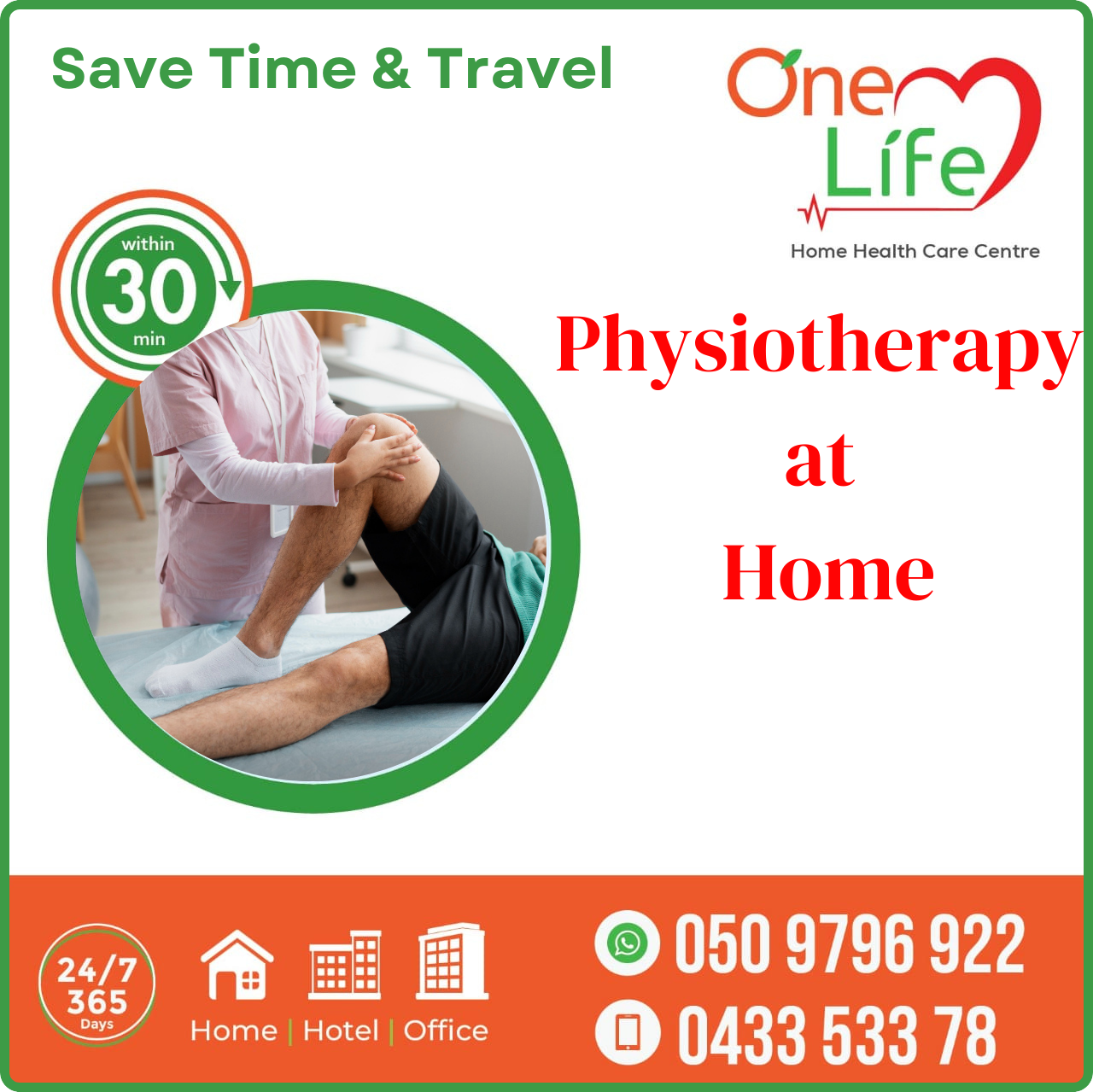Physiotherapy Near Me - We are Specialized in pediatric Physiotherapy, geriatric physiotherapy , Mobility Physical Therapy, Stroke Physiotherapy, women's health Physiotherapy, occupational therapy, vestibular rehabilitation, neurological rehabilitation, Home Physiotherapy in Dubai at your place | Private Physiotherapist At Home in Dubai | Physiotherapy Dubai Price AED 350
People who seeks physiotherapy at home, where they find it challenging to go the physiotherapy clinic with their existing pain and waiting in the queue for appointment and their recovery get more challenging when they require a bed rest. Now Onelife homehealthcare provides Physiotherapy at home or home physiotherapy for the people who seeks for it at their own home.Curated home physiotherapy session based on the individual needs.Now no more travelling outside to go for the physiotherapy session and waiting in the queue.Home Physiotherapy in Dubai at home service, is delivered as per your need and convenience.The number of home physiotherapy sessions depends on the symptom and individual needs of physiotherapy session.
Immediate appointment - 24x7 service - Call 0509796922. Cost 350Aed per session. DHA licensed Facility and DHA certified expert physiotherapist.Our home physiotherapy services also comes in packages if the doctor advised for certain number of home physiotherapy session then we also have a package pricing for physio therapy sessions.Home Physiotherapy is now affordable and at your home. Save your self from outside travel where physiotherapy at home.
Home Physiotherapy quality of care will almost be same as clinic physiotherapy Service.Insted of you going to clinic our expert and DHA licensed physiotherapist will come to your doorstep and provide physiotherapy service at your own comfort which implies for faster recovery with minimal discomfort. The home physiotherapy is ideal for those client who are elder and not able to go outside. And also for those who did surgery and need maximum bedrest.If you are looking for physiotherapy services and searching for physiotherapy Clinic in Dubai or Home Physiotherapy Near Me, Do not worry. Now you Can Just Call +971 509796922 and get Immediate Physiotherapy at Home at your doorstep within 30-45 min. Our Team Is immediately available 24x7 at Your Home Hotel Office - 365 days round the clock. Instant Appointment without any delay. Physiotherapy Available at your doorstep.
Now no more worries,physiotherapy is now at your home. Our program includes
01
Physiotherapy for Lumbar Radiculopathy
Our specialized program focuses on relieving the pain and discomfort associated with lumbar radiculopathy, helping you regain mobility and improve your daily life.
02
Ankle Sprain Physiotherapy
We provide tailored physiotherapy treatment to heal and strengthen your ankle after a sprain, promoting stability and preventing future injuries.
03
Meniscus Tear Physiotherapy
Our program offers targeted exercises and therapies to facilitate the recovery and rehabilitation of meniscus tears, restoring knee function.
04
Frozen Shoulder Physiotherapy
Regain shoulder mobility and alleviate the stiffness and pain of frozen shoulder with our comprehensive physiotherapy plan.
05
Hip Pain Physiotherapy
Experience relief from hip pain and regain optimal hip function through our personalized physiotherapy rehabilitation program.
06
ACL Rehabilitation Physiotherapy
Our structured ACL rehabilitation physiotherapy program aims to restore knee stability and strength after an injury, ensuring a safe return to sports and daily activities.
07
Physiotherapy for Tennis Elbow
Alleviate the discomfort of tennis elbow with our proven therapies and exercises, promoting a full recovery.
08
Neck Pain Physiotherapy
Targeted neck pain management through physiotherapy helps relieve tension and improve neck function for a pain-free life.
09-
Back Pain Physiotherapy
Our program offers effective solutions to address back pain, enhancing your spine's health and function.
10
Tendonitis Physiotherapy
We provide specialized care for tendonitis, reducing inflammation and promoting optimal tendon healing.
11
Ligament Sprain Physiotherapy Management
Our comprehensive approach ensures proper healing and strengthening of ligaments following a sprain, minimizing the risk of re-injury.
12
Herniated Disk Physiotherapy
Experience relief from the pain and discomfort associated with herniated disks through our tailored rehabilitation program.
We offer targeted physiotherapy to address PIVD (Prolapsed Intervertebral Disc), promoting pain reduction and improved spine health.
14
Pain Relief Physiotherapy for Knee
Our program focuses on pain management and knee rehabilitation to enhance your comfort and mobility.
15
Physiotherapy for Slip Disk
Our specialized care aids in slip disk recovery, promoting spine health and reducing pain and discomfort.
16
Physiotherapy for Stroke
Regain your mobility and independence through our stroke rehabilitation program, tailored to your unique needs.
17
Physiotherapy for Parkinson's
Improve your quality of life and manage the symptoms of Parkinson's disease with our specialized physiotherapy techniques.
18
Physiotherapy for Muscle Strain
Our program is designed to facilitate the healing and strengthening of strained muscles, allowing you to return to your regular activities pain-free.
Our Physiotherapy services available in Dubai we cover major areas in Dubai like Dubai marina,jvc,Down town,discovery garden, al barsha, nad al hamar, jabel ali,
Orthopedic Physiotherapy:
Orthopedic physiotherapy, also known as orthopedic physical therapy, is a specialized branch of physical therapy that focuses on the assessment, diagnosis, and treatment of musculoskeletal conditions and injuries. This area of physiotherapy is dedicated to helping individuals of all ages regain optimal function, mobility, and pain relief in relation to their bones, muscles, ligaments, tendons, and joints.
Here are some key aspects of orthopedic physiotherapy:
01
Assessment and Diagnosis
Orthopedic physiotherapists are experts in evaluating musculoskeletal problems. They conduct comprehensive assessments to identify the root cause of issues such as joint pain, muscle weakness, limited range of motion, or post-surgery recovery.
02
Individualized Treatment Plans
Following a thorough assessment, orthopedic physiotherapists develop personalized treatment plans tailored to the patient's specific needs and goals. These plans may include a combination of exercises, manual therapy, modalities (such as ultrasound or electrical stimulation), and education on self-care and injury prevention.
03
Post-Surgery Rehabilitation
Orthopedic physiotherapy plays a crucial role in post-surgery recovery. Patients who have undergone procedures like joint replacements, ligament repairs, or spinal surgeries benefit from carefully designed rehabilitation programs to regain strength, mobility, and function.
Orthopedic physiotherapists use various techniques to manage and alleviate pain associated with musculoskeletal conditions. These may include joint mobilization, soft tissue massage, and therapeutic exercises.
05
Rehabilitation for Sports Injuries
Athletes with sports-related injuries, such as sprains, strains, or fractures, turn to orthopedic physiotherapy to recover quickly and safely. The focus is on not only healing the injury but also preventing future recurrences.
06
Muscle Imbalances and Posture Correction
Orthopedic physiotherapists help patients address muscle imbalances, poor posture, and faulty movement patterns. Correcting these issues can reduce the risk of injuries and chronic pain.
07
Education and Prevention
Part of orthopedic physiotherapy involves educating patients about their condition, teaching them how to manage symptoms, and providing guidance on preventive measures. This empowers individuals to take an active role in their own health.
08
Orthotics and Assistive Devices
Orthopedic physiotherapists may recommend and fit orthotic devices, braces, or assistive equipment to improve mobility and alleviate pain.
Throughout the rehabilitation process, orthopedic physiotherapists continually assess progress and adjust treatment plans as needed to ensure the best possible outcomes.
10
Functional Restoration
The ultimate goal of orthopedic physiotherapy is to restore patients to their optimal level of physical function and improve their overall quality of life. Whether it's walking, bending, lifting, or participating in sports, orthopedic physiotherapy aims to enhance an individual's ability to perform daily activities without limitations.
Orthopedic physiotherapy is essential for individuals recovering from injuries, surgeries, or those dealing with chronic musculoskeletal conditions. It not only helps in the healing process but also empowers patients to lead healthier, more active lives while minimizing the risk of future problems.
Geriatric physiotherapy
Geriatric physiotherapy, often referred to as geriatric physical therapy, is a specialized branch of physical therapy focused on the unique needs of older adults. As individuals age, they may face a variety of physical and functional challenges, including decreased mobility, balance issues, chronic pain, and age-related medical conditions. Geriatric physiotherapists are trained to address these specific concerns and improve the overall quality of life for seniors. Here's an overview of the key aspects of geriatric physiotherapy:
Geriatric physiotherapists begin by conducting a comprehensive assessment of an older individual's physical condition. This includes evaluating strength, balance, flexibility, and mobility. They also take into account any pre-existing medical conditions, such as arthritis, osteoporosis, or heart disease.
Falls are a significant concern among seniors, as they can lead to serious injuries. Geriatric physiotherapy often includes fall prevention strategies, focusing on improving balance, gait, and coordination to reduce the risk of accidents.
Older adults may experience chronic pain due to conditions like arthritis or degenerative joint diseases. Geriatric physiotherapists use various techniques, including manual therapy, exercise, and modalities, to manage pain and improve joint function.
Maintaining or regaining mobility is a primary goal of geriatric physiotherapy. This involves exercises and activities that help seniors stay active, regain their independence, and perform daily tasks with ease.
05
Post-Operative Rehabilitation
Seniors often undergo surgeries such as joint replacements or cardiac procedures. Geriatric physiotherapy plays a critical role in post-operative rehabilitation, aiding in the recovery process and ensuring a safe return to daily activities.
06
Chronic Disease Management*
Many older adults live with chronic medical conditions like diabetes, hypertension, or chronic obstructive pulmonary disease (COPD). Geriatric physiotherapists work in conjunction with other healthcare providers to help manage these conditions through exercise and lifestyle modifications.
07
Cognitive and Neuromuscular Function
Some seniors may experience cognitive decline or neuromuscular disorders. Geriatric physiotherapy can include interventions that target cognitive function and address conditions like Alzheimer's or Parkinson's disease.
08
Assistive Devices and Adaptive Techniques
Geriatric physiotherapists may recommend and teach the use of assistive devices like canes, walkers, or orthotic braces, as well as adaptive techniques to help older adults maintain independence and mobility.
Staying socially active is essential for mental and emotional well-being in older adults. Geriatric physiotherapists may incorporate group activities and exercises to encourage social interaction and reduce isolation.
10
Home Safety Evaluations
Geriatric physiotherapists often conduct home assessments to identify potential hazards and recommend modifications to improve the safety and accessibility of the home environment.
11
Education and Caregiver Support
Educating seniors and their caregivers about the importance of physical activity, nutrition, and fall prevention is a vital part of geriatric physiotherapy. Caregivers may also receive training on how to assist and support their loved ones effectively.
Geriatric physiotherapy aims to enhance the overall well-being of older adults, helping them maintain or regain their independence, manage chronic conditions, and enjoy a higher quality of life. By addressing the specific needs and challenges of the elderly population, this specialized form of physical therapy plays a crucial role in promoting healthy aging and maintaining functional independence.
Frozen shoulder physiotherapy
Frozen shoulder, also known as adhesive capsulitis, is a condition characterized by pain, stiffness, and limited range of motion in the shoulder joint. This condition often develops gradually and can be quite debilitating, particularly in its advanced stages. Physiotherapy is a key component of the treatment for frozen shoulder, helping patients regain mobility and alleviate pain. Here's an overview of the role of physiotherapy in managing frozen shoulder:
01
Assessment and Diagnosis
The first step in frozen shoulder physiotherapy is a thorough assessment. The physiotherapist evaluates the patient's range of motion, pain levels, and the impact of the condition on their daily activities. This assessment helps determine the severity of the frozen shoulder and guides the development of a tailored treatment plan.
Pain is a common and distressing symptom of frozen shoulder. Physiotherapists use various techniques, such as manual therapy, modalities like heat or ice, and gentle exercises to reduce pain and inflammation.
03
Range of Motion Exercises
A primary focus of physiotherapy for frozen shoulder is to gradually restore the shoulder's range of motion. This involves a series of exercises and stretches aimed at stretching the joint capsule and soft tissues, helping to alleviate stiffness.
04
Strengthening Exercises
As the patient's range of motion improves, strengthening exercises are introduced to build the muscles around the shoulder joint. This enhances stability and supports the joint as it regains function.
Physiotherapists use manual techniques to mobilize the shoulder joint gently. These techniques help
Correcting posture and body mechanics is crucial for preventing the recurrence of frozen shoulder. Physiotherapists educate patients on proper posture and body movements to reduce stress on the shoulder joint.
Education is a vital aspect of frozen shoulder physiotherapy. Patients are informed about the condition, its expected progression, and the importance of adherence to the prescribed exercises and self-care techniques.
08
Home Exercise Programs
Patients are often given home exercise programs to continue their rehabilitation independently. These exercises help reinforce the progress made during physiotherapy sessions and accelerate recovery.
09-
Functional Activities
Physiotherapists work with patients to regain the ability to perform daily tasks and activities that have been affected by the frozen shoulder. This may include reaching, lifting, and even more complex movements, depending on the individual's goals.
For some patients, frozen shoulder can be a chronic condition with a tendency to recur. In such cases, physiotherapists may provide ongoing support and management to maintain shoulder function and minimize future flare-ups.
11
Collaboration with Other Healthcare Providers
Physiotherapists often collaborate with orthopedic surgeons or other healthcare professionals to ensure a comprehensive approach to frozen shoulder treatment, especially in cases where surgical intervention may be necessary.
Frozen shoulder can be a challenging condition to manage, but with the guidance and expertise of a physiotherapist, individuals can experience significant improvements in pain relief, range of motion, and overall shoulder function. The goal of frozen shoulder physiotherapy is to help patients regain their independence and quality of life by addressing the specific needs of their condition.
Stroke physiotherapy
Stroke physiotherapy, also known as stroke rehabilitation, is a specialized branch of physiotherapy that plays a crucial role in helping individuals recover and regain their quality of life after suffering a stroke. Stroke is a sudden disruption of blood flow to the brain, which can result in a wide range of physical, cognitive, and emotional impairments. Stroke physiotherapy focuses on maximizing a patient's functional independence and overall well-being. Here's an overview of the key aspects of stroke physiotherapy:
01
Assessment and Goal Setting
Stroke physiotherapy begins with a comprehensive assessment of the patient's physical and functional capabilities. The physiotherapist evaluates strength, balance, mobility, and the impact of the stroke on daily activities. Based on this assessment, personalized goals are established for the rehabilitation process.
Early intervention is critical in stroke rehabilitation. Physiotherapists work closely with the medical team to initiate rehabilitation as soon as the patient's condition stabilizes. This helps prevent complications, maintain joint flexibility, and improve the chances of a successful recovery.
03
Mobility and Walking Training
One of the primary goals of stroke physiotherapy is to regain mobility and the ability to walk. Patients may undergo exercises to improve balance, gait, and muscle strength. Assistive devices such as canes or walkers may be introduced as necessary.
04
Range of Motion and Strength Exercises
Physiotherapists employ exercises to improve range of motion and muscle strength in affected limbs. This can include resistance training, stretching, and coordination exercises.
05
Functional Task Training
Stroke patients are guided through exercises and tasks that simulate daily activities, helping them regain the skills required for independent living. This may include dressing, cooking, or personal hygiene tasks.
Many stroke survivors experience muscle spasticity or stiffness, which can affect mobility and comfort. Physiotherapists use techniques such as stretching and splinting to manage spasticity.
Physiotherapists work on pain relief strategies for individuals who experience pain as a result of muscle imbalances or compensatory movements.
08
Balance and Coordination
Balance training and coordination exercises are essential components of stroke physiotherapy. These exercises reduce the risk of falls and improve overall mobility.
Physiotherapists teach stroke survivors adaptive techniques and strategies for overcoming daily challenges, such as using specialized equipment or modifying home environments to enhance safety.
10
Home Exercise Programs
Patients are often provided with home exercise programs to continue their rehabilitation independently. These exercises help maintain and build upon the progress achieved during in-clinic physiotherapy sessions.
11
Cognitive Rehabilitation
Stroke can affect cognitive functions such as memory, attention, and problem-solving. Some stroke physiotherapists incorporate cognitive rehabilitation exercises to address these issues.
12
Emotional and Psychological Support
Coping with the physical and emotional challenges of stroke can be overwhelming. Physiotherapists often offer emotional support and motivation to help patients stay engaged and committed to their rehabilitation.
13
Collaboration with Other Healthcare Providers
Stroke physiotherapists work collaboratively with neurologists, speech therapists, occupational therapists, and other healthcare professionals to provide a comprehensive approach to stroke rehabilitation.
Stroke physiotherapy is a dynamic and individualized process that aims to optimize functional recovery and quality of life for stroke survivors. It helps individuals regain their independence and improve their physical and cognitive abilities, ultimately allowing them to reintegrate into their communities and lead fulfilling lives.
Musculoskeletal physiotherapy
Musculoskeletal physiotherapy, also known as orthopedic physiotherapy, is a specialized field of physical therapy that focuses on the assessment, diagnosis, and treatment of conditions related to the musculoskeletal system. This system includes the bones, joints, muscles, ligaments, tendons, and other connective tissues. Musculoskeletal physiotherapists are experts in managing a wide range of issues, from acute injuries to chronic conditions, with the goal of reducing pain, improving mobility, and enhancing the overall quality of life. Here's an overview of the key aspects of musculoskeletal physiotherapy:
01
Assessment and Diagnosis
The foundation of musculoskeletal physiotherapy is a thorough assessment of the patient's condition. The physiotherapist examines the affected area to identify the root cause of pain, dysfunction, or mobility limitations. This assessment informs the development of a tailored treatment plan.
Many musculoskeletal conditions are associated with pain, which can be acute or chronic. Physiotherapists use a variety of techniques, including manual therapy, modalities (such as heat or cold therapy), and specific exercises to manage pain and reduce inflammation.
03
Range of Motion and Flexibility
One of the primary goals of musculoskeletal physiotherapy is to improve range of motion and flexibility in the affected area. This often involves a series of exercises and stretches designed to alleviate stiffness and restore function.
04
Strengthening Exercises
Muscle weakness and imbalances are common in musculoskeletal conditions. Physiotherapists prescribe targeted exercises to strengthen the muscles around the affected joint, promoting stability and preventing further injury.
Manual techniques, including joint mobilization and manipulation, are used to improve joint mobility and reduce restrictions. These hands-on methods help enhance joint function.
Poor posture can contribute to musculoskeletal issues. Physiotherapists educate patients on proper posture and body mechanics, helping them reduce strain on their musculoskeletal system.
07
Functional Rehabilitation
Musculoskeletal physiotherapy emphasizes the restoration of functional abilities, allowing patients to return to their normal activities and routines. This includes addressing limitations in everyday tasks and physical activities.
08
Soft Tissue Management
Physiotherapists may use techniques such as myofascial release, deep tissue massage, and trigger point therapy to address soft tissue injuries and imbalances.
Preventive care is a key aspect of musculoskeletal physiotherapy. Patients are educated on techniques to minimize the risk of future injuries or chronic conditions.
Musculoskeletal physiotherapists develop customized exercise programs that patients can perform at home. These programs help reinforce progress made during physiotherapy sessions.
11
Management of Chronic Conditions
Patients with chronic musculoskeletal conditions such as arthritis or fibromyalgia benefit from ongoing care to manage pain and maintain function.
12
Collaboration with Other Healthcare Providers
Musculoskeletal physiotherapists often collaborate with orthopedic surgeons, primary care physicians, and other specialists to ensure a holistic and comprehensive approach to patient care, especially in cases that may require surgical intervention.
Musculoskeletal physiotherapy is instrumental in helping individuals of all ages, whether they are recovering from an injury, managing a chronic condition, or seeking to enhance their overall musculoskeletal health. By addressing the unique needs of each patient, this specialized form of physical therapy aims to reduce pain, improve mobility, and promote a higher quality of life.








